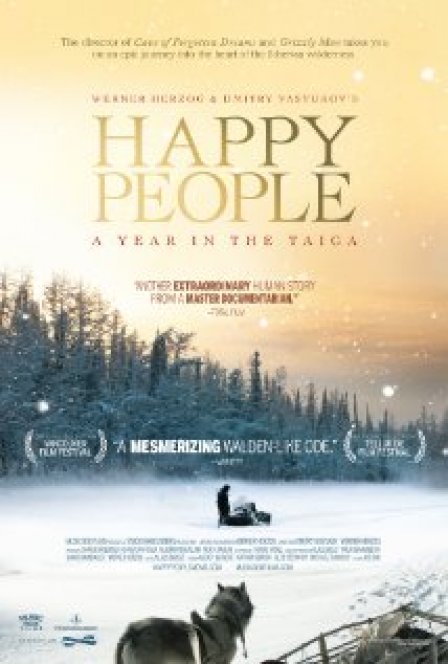All of the footage in Happy People: A Year in the Taiga was shot in one year by Dmitry Vasyukov’s crew in the remote and harsh environment of Bakhtia, Siberia. The material was then edited into a four-hour television series in Russia. Famed director Werner Herzog became interested in this material and shaped a 94-minute version for international audiences with the help of his trusted editor, Joe Bini. His new version also includes narration that was written by Werner Herzog himself and his son, Rudolph. In his 2005 film Grizzly Man, Herzog also worked with footage he did not himself capture, in what turned out to be one of the director’s most compelling works in recent times. Yet what made Grizzly Man so original was Herzog’s ability to counter-argue and dispute with this estranged man who tragically died due to his own (as Herzog would argue) naïve ideals. During the 95 minutes that comprise Happy People: A Year in the Taiga, on the other hand, Herzog’s narration is mostly uninspired and too often it seems as if he’s just going through the motions of performing his eccentric persona.
The overall argument in the film could only be described as an anthropologist’s nightmare. Closer to Nanook of the North than Grizzly Man, Herzog often marvels at how these people still maintain their traditional ways and are “truly free” without taxes, government, laws, or bureaucracy. They are, as he narrates them, self-reliant, happy people who live off the land. One of the few modern artifacts they use is a chainsaw (though the homes are also equipped with television sets, something Herzog never mentions). This is a major problem in trying to reconstruct a social environment without having taken part in the subject’s daily lives: it’s too easy to disregard the complexity of human life and to dwell in the safety of our preconceived notions. Happy People: A Year in the Taiga mostly deals with the trappers and their material culture. There is barely any screen time devoted to the social organization of the villagers, family life, their symbolic system, societal norms, or the women (one of the rare moments when we hear women speak is when they bid farewell to their husbands who are going off on a winter hunting season). Demand for traditionalism is often dangerous for indigenous people all over the world: the kid wearing a Pokémon t-shirt in the Taiga or the Brazilian native wearing soccer shirts can both too easily be dismissed as not traditional enough to deserve state help, support, or legislation on indigenous rights.
One of the documentary’s high points is when the trapper Gennady Soloviev meditates on the ethics behind the act of killing an animal. He elaborates on how he feels better working as a trapper than slaughtering cattle, something he could never perform due to the affection of having lived alongside the animal. “In the taiga”, he says “the wild animal knows that no good can come from me, man. Here it’s about who outsmarts whom.” This is a moment when I expected Herzog to reflect on what this man had just said about his strange profession and his relationship with nature, but yet again, the footage becomes more interesting than the treatment Herzog provides for it.
While there are moments of pure Herzogian gold (his pronunciation of the word “bears” never gets old) and much breathtaking footage overall, it’s not nearly enough to save the film from its run-of-the-mill meditation and reproduction of troublingly naturalized ideas. In contrast to how Herzog once contested an idealized vision of nature in Grizzly Man, he here fails to deconstruct his own idealized view of traditional life, whatever that term may mean. It’s always a joy to hear Herzog speak — it’s such a shame he had so little to say this time.

